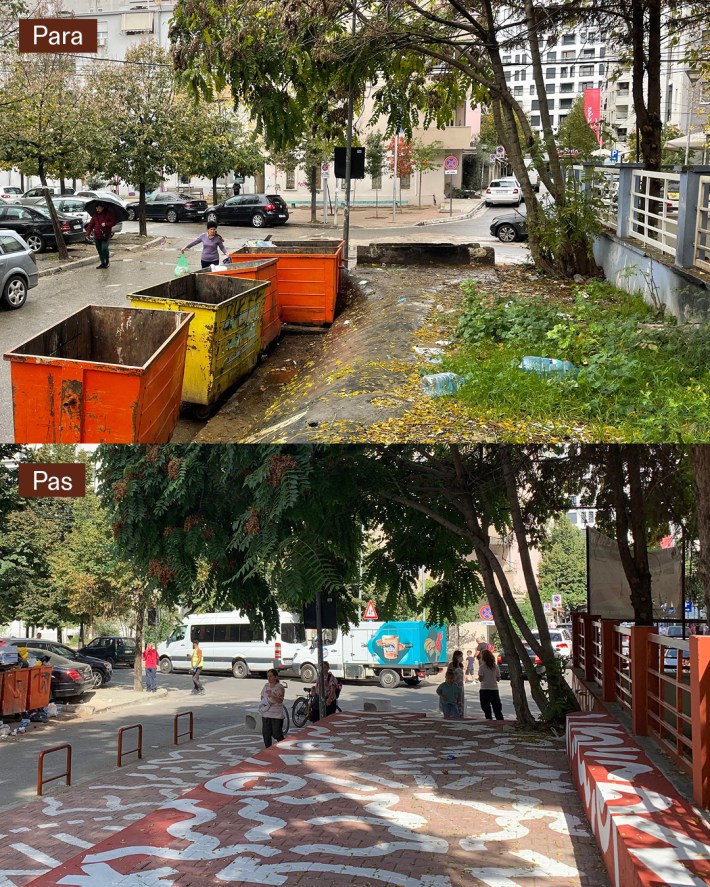One European city is on track to bring the revolutionary "school streets" model to every child who lives within it borders — and it's throwing down the gauntlet to U.S. communities that have been slow to embrace the game-changing concept.
Last week, the Albanian capital of Tirana announced that it would make a nearly 1 million euro investment this year to convert 20 streets near neighborhood schools into permanent "school streets," which either banish or significantly limit car traffic from roads near learning centers and redesign primarily them around children's needs instead. The effort will double the number of kid-friendly corridors in the city of 528,000 this year, and get it 40 percent of the way towards its goal of protecting every neighborhood school by 2026.
But the real proof of Tirana's school street success is already evident in photos, which are bursting with images of children enjoying space that was once dedicated to parking.

First piloted in Italy in 1989, the school streets model exploded in popularity during the pandemic, cropping up in more than 1,250 communities worldwide by April 2022, up from just 20 in 2019. Outside of a handful of communities like New York City and Seattle, though, few of those places were in the U.S., which typically relies on school zones that require drivers to slow down a bit when kids are present, but don't always install infrastructure to back up those lower limits — much less fundamentally rethink what roads near schools are for.
Advocates in New York, meanwhile, have complained that school streets haven't been installed at enough schools, even as cities like Tirana have expanded aggressively.

Tirana's "Streets for Kids" program — aka “Rrugët për Fëmijët” — isn't just remarkable for how fast it's grown. The city has used the initiative not just to re-dedicate space to little pedestrians, but to install new play spaces, lighting, and benches, while planting trees and sustainable stormwater management elements. And those assets have benefits for residents long after the final school bell rings.
“Eighty percent of the public space in European cities is streets," said Simon Battisti, director of Qendra Marrëdhënie (Relationship Center), an urban planning nonprofit that co-led the effort. "School streets not only improve safety where children and parents need it most, but they also kick-start a larger conversation about shifting priority away from cars to pedestrians in the city. Cities everywhere can learn from what Tirana has been able to do."
Of course, a Balkan capital that dates back to the Ottoman Empire isn't strictly comparable to younger American cities built around the automobile. Still, Tirananians say they have their own struggles with car culture — and if they can do this, anyone can.

“Our streets are clogged and when you ask people why that is, the answer is always the same: ‘Albanians love their cars,’" said Deputy Mayor Anuela Ristani. "I don’t think that’s really the case. I am pretty sure it is because walking is still often just too uncomfortable. That has to change, and projects like the school streets show that that change is not only possible, but it’s quick."
Ristani says that school streets program can be a powerful tool for spatializing feminism, and making cities more equitable for people of all ages.
"We also have to ask, ‘Who is actually driving?’" she adds. "We know most people behind the wheel on a given day in Tirana are men. We know kids under 16 don’t drive, and we know that very few elderly drive. Our school streets show loud and clear what we sacrifice by choosing to store cars on the street instead of using that precious public space for people.”

Tirana's city leaders hope that their new investment will even further strengthen their standing as a global school streets leader, a title they already share with programs like Barcelona’s “Protegim les Escoles,” “Strade Scolastiche” in Milan,
and “Rues aux Écoles” in Paris. And as these programs continually proliferate — including, hopefully, in the U.S. — it could catalyze a powerful conversation not just about what it means to be a child-friendly community.
“Children spend more time at school than anywhere other than home," said Tirana Mayor Erion Veliaj. "When we decided to take kids seriously in this city, schools were the logical place to start. We are incredibly proud to build this legacy of safety for every child in Tirana for decades to come.”






